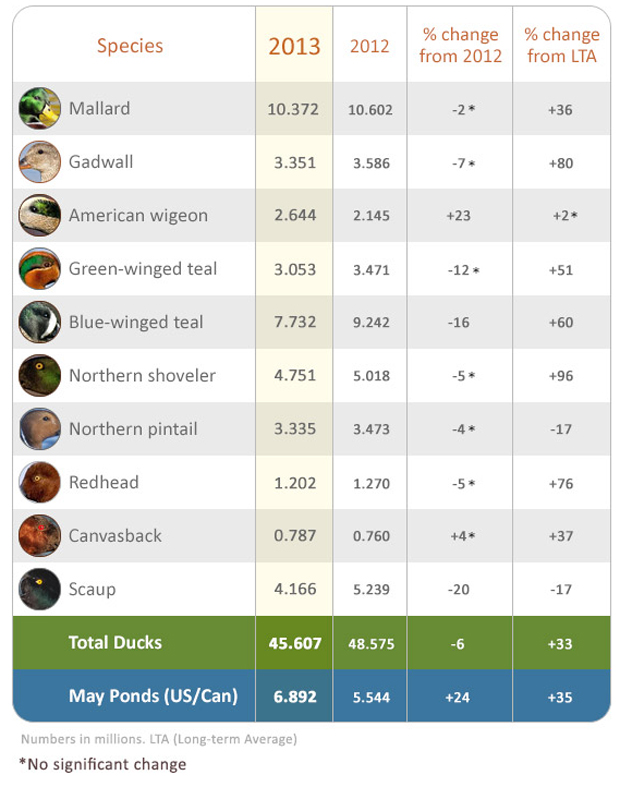July 15, 2013
By Florida Sportsman Editor
 Source : www.ducks.org
Source : www.ducks.org
Memphis--Duck numbers overall remain strong this year. Despite slight declines, most species remain well above long-term averages.
The US Fish and Wildlife Service today released its report on 2013 Trends in Duck Breeding Populations, based on surveys conducted in May and early June. Total populations were estimated at 45.6 million breeding ducks in the surveyed area. This estimate represents a 6-percent decrease from last year's estimate of 48.6 million birds, and is 33 percent above the 1955-2012 long-term average.
“This spring saw abundant moisture in much of the heart of North America's most important duck breeding areas,” said DU Chief Scientist Dale Humburg. “That bodes well for duck breeding success this summer and hopefully for hunting this fall. But we remain concerned with continuing loss of nesting habitat in these areas. Because ducks need both water and upland habitats to successfully raise their young, the ongoing loss of grasslands and wetlands across the Prairie Pothole Region will continue to impact the number of ducks in the fall flight.”
“We must maintain our focus on protecting and restoring important habitat across the birds' range in order to see these kinds of numbers in future wet years,” said DU CEO Dale Hall.
The main determining factor for duck breeding success is wetland and upland habitat conditions in the key breeding landscapes of the prairies and the boreal forest. Conditions observed across the U.S. and Canadian survey areas during the 2013 Waterfowl Breeding Population and Habitat Survey were improved or similar to last year in many areas due to average to above average annual precipitation, with the exception being southeastern Canada, south-central Alberta along the Montana border, the northeast U.S. and portions of Montana and the Dakotas. Total pond counts for the United States and Canada combined showed 6.9 million ponds, a 24-percent increase from last year's estimate and 35 percent above the long-term average.
Of the 10 species surveyed, 7 were similar to last year's estimates, including mallards. Scaup and blue-winged teal were significantly below last year's estimates. American wigeon were 23 percent above last year. Mallards, similar in number to 2012, are 36 percent above the long-term average. Two species (northern pintail and scaup) remained below their long-term average and North American Waterfowl Management Plan goals.
“This year we also experienced very late winter conditions across much of the United States and Canada,” said Humburg. “These conditions delayed the arrival of some ducks on their traditional breeding grounds and may have impacted breeding and nesting success. Even with abundant moisture on the prairies and good breeding success this year, the weather and habitat conditions the birds encounter on their fall migrations will impact local hunting success. Many areas along traditional migration routes are experiencing significant drought, and this will likely have an effect on how many birds hunters see this fall. Other areas have seen excessive moisture, which could affect food supplies for migrating birds. And, as always, weather patterns can also have a huge impact on local hunting conditions and the timing of the migration.”
The spring surveys provide the scientific basis for many management programs across the continent, including hunting season dates and bag limits. The four flyway councils and the US Fish and Wildlife Service Regulations Committee will meet in late July to recommend the season structure and bag limits for 2013-14. Individual states will make their specific selections within a federal framework of season length, bag limit and dates. Hunters should check the rules in their states for final dates.
View all the data and get a species-by-species breakdown at www.ducks.org/2013ducknumbers
